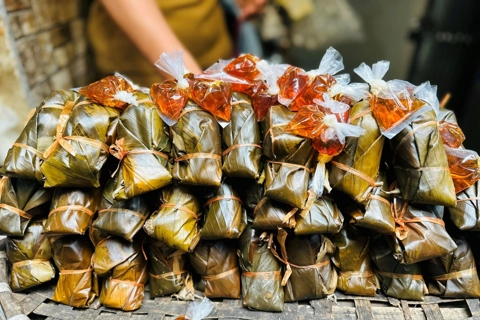Life
Goat to curry divine favour for Vietnam
Feb 25, 2015 / 01:44 PM
Vietnamese people are celebrating the new year as the Year of the Goat, the eighth zodiac animal in the lunar calendar.
The goat represents a moderate and mild temperament, and thus people expect good and favourable things to happen during the new year.
In Vietnamese culture, the goat is one among six domestic animals – the others being dog, buffalo, horse, pig and rooster– and is not involved in any activity outside farms. The goat, therefore, does not have any place in history and culture, compared to the horse, last year's zodiac animal.
Even so, the goat is linked to the childhood of every Vietnamese child, thanks to the folk game of Bit Mat Bat De (catching the goat while blindfolded).
Originally, the game included a girl, a boy and a goat within a fenced area. The blindfolded girl/boy had to try and catch the goat. The game, which is still played in some areas in the northern mountainous localities and the central province of Quang Nam, is fun for the audience as the girl and the boy often end up catching each other, instead of the goat.
The game was depicted in the folk paper paintings of Dong Ho Village in the northern province of Bac Ninh and Sinh village in the central province of Thua Thien-Hue.
Children around the country today play the game, with one blindfolded child trying to catch the others within a circle drawn on the floor. The one who is caught by the blindfolded child is the next one to be blindfolded.
In the northern provinces of Ha Giang and Tuyen Quang, goat-fighting festivals are held annually in the second month of the lunar year for the entertainment of local people. The goats selected for the competition are strong, mature and male, and are categorised according to their weight.
The winner of each game is determined by the total marks the judges give in the form of kicks. In contrast to other animal-fighting events, the lives of goats participating in these games are spared.
The goat has been featured in Vietnamese culture as sacrifices offered to gods in grand ritual ceremonies, and in paintings on porcelain items that Vietnamese kings ordered from China.
The Nguyen dynasty (1802-1945) kings, for instance, had a platform for worshipping gods who were believed to hold the fate of the kings in their hands. Rituals held on the platform were of high significance and were conducted with very complicated procedures. The sacrificial animals had to be goats, cows and pigs.
Experts have not explained clearly how the animals were selected, but believe that they represented animal husbandry, together with agricultural products such as rice. The bodies of the animals, kept in the kneeling position, were disembowelled and grilled.
The offerings were made to thank the god for ensuring good weather for bumper crops.
Similar offerings are also made at grand annual ceremonies in traditional villages.
On porcelain items, the goat appears in drawings that show three goats grazing comfortably or playing, representing good luck and happiness.
Wood carvings showing goats being hunted by tigers are found on the outer wooden walls of communal houses of the ethnic Co Tu in Quang Nam province.
In Vietnamese culture, the goat is one among six domestic animals – the others being dog, buffalo, horse, pig and rooster– and is not involved in any activity outside farms. The goat, therefore, does not have any place in history and culture, compared to the horse, last year's zodiac animal.
Even so, the goat is linked to the childhood of every Vietnamese child, thanks to the folk game of Bit Mat Bat De (catching the goat while blindfolded).

The game of catching the goat while blindfolded is held in a mountainous village in Quang Nam province
|
The game was depicted in the folk paper paintings of Dong Ho Village in the northern province of Bac Ninh and Sinh village in the central province of Thua Thien-Hue.
Children around the country today play the game, with one blindfolded child trying to catch the others within a circle drawn on the floor. The one who is caught by the blindfolded child is the next one to be blindfolded.
In the northern provinces of Ha Giang and Tuyen Quang, goat-fighting festivals are held annually in the second month of the lunar year for the entertainment of local people. The goats selected for the competition are strong, mature and male, and are categorised according to their weight.
The winner of each game is determined by the total marks the judges give in the form of kicks. In contrast to other animal-fighting events, the lives of goats participating in these games are spared.
The goat has been featured in Vietnamese culture as sacrifices offered to gods in grand ritual ceremonies, and in paintings on porcelain items that Vietnamese kings ordered from China.
The Nguyen dynasty (1802-1945) kings, for instance, had a platform for worshipping gods who were believed to hold the fate of the kings in their hands. Rituals held on the platform were of high significance and were conducted with very complicated procedures. The sacrificial animals had to be goats, cows and pigs.
Experts have not explained clearly how the animals were selected, but believe that they represented animal husbandry, together with agricultural products such as rice. The bodies of the animals, kept in the kneeling position, were disembowelled and grilled.
The offerings were made to thank the god for ensuring good weather for bumper crops.
Similar offerings are also made at grand annual ceremonies in traditional villages.
On porcelain items, the goat appears in drawings that show three goats grazing comfortably or playing, representing good luck and happiness.
Wood carvings showing goats being hunted by tigers are found on the outer wooden walls of communal houses of the ethnic Co Tu in Quang Nam province.








